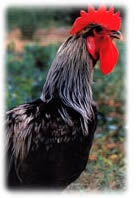DENİZLİ ROOSTER
Each rooster crows at its own place
But Denizli Rooster crows everywhere.
 "Thanks God, I have everything here. Only one thing is missing in my life here: Cock crowing... said a rich businessman living in New York. The rooster he was talking about was Denizli rooster. While he was expressing his missing of the rooster, he was also expressing a reality of the modern world.
"Thanks God, I have everything here. Only one thing is missing in my life here: Cock crowing... said a rich businessman living in New York. The rooster he was talking about was Denizli rooster. While he was expressing his missing of the rooster, he was also expressing a reality of the modern world.
"I was born at dawn time in Denizli while roosters were crowing.... Then I used to wake up with the same sound for many years... I was getting out of my bed with the sound of my rooster every morning at a regular time like a clock set. Let me tell you something now..... I have not heard any rooster crowing here for 21 years...The thing that modern city life has taken out off me is rooster crowing sound which is sweeter than gold sound... Contemporary city life, at the very beginning, stops the sound of rooster..."
"Denizli Rooster", the symbol of Denizli, is a domestic species which is well known in even the farthest regions for its colour, body building, and it's harmonious long and beautiful crowing. According to some rumours, Berat roosters with long crowing were brought to Istanbul during the Ottoman Empire from Albania to Denizli. They were then crossbred with domestic chickens of Denizli creating the Domestic breed. This, however, is not true because there are no similarities between the two species when compared in terms of colour and body structure. The Denizli rooster came to be from the great care shown by the people living in Denizli to the long crowing rooster for centuries.
The colour of the Denizli rooster's eyes is black and blackened with kohl. Its legs are dark grey or purple, its comb is a big axe comb, and it's atrium has red or white spots on a red background. It's general colour is black and dirty white together, while some wing features have brown colours. Red roosters have a black-white mixture. Their living weight is about 3-3.5 kg. They are divided into 3 groups according to their colours, body build and comb type. According to their colours they are classified into 6 groups as: DEMİRKIR, PAMUKKIR, KINALI, AL, SİYAH and KÜRKLÜ. According to their body build, they are divided into 3 types, namely: YÜKSEK BOYUN, SÜLÜN and KÜPELİ. According to their combs, they are divided into 2 types: GENİŞ İBİK and DAR İBİK.
The sound of Denizli roosters are classified according to the tone and clearness. According to sound tones they are divided into 3 groups: İNCE, DAVUDİ, KALIN SES. Davudi (bass) voice is between high pitched and deep voice and is the only sound close to deep voice. According to clearness, they are divided into 4 groups, namely: SAD VOICE, SHRILL VOICE, WAVY VOICE (FUNNY VOICE).
Crowing of Denizli roosters is performed upon use of all abilities. Crowing is divided into 4 groups depending on body position during crowing, which are LION CROWING, WOLF CROWING, HERO CROWING, PUS CROWING.
A good Denizli Rooster must have: alive appearance, long and strong legs and neck, wide and deep chest, and a sharp tail sloped toward it's head. The same features are true for the chicken. The crowing period of Denizli Roosters in the first year must be 20 to 25 seconds.
Denizli roosters are being bred by a Denizli species production unit formed under the abody of Director of Province Agricultural Affairs and are maintained generally in 100 flocks. Breeding roosters are selected and the rest are sold according to the demands made from various parts of the country from March and April, and sales of chicks are made in March, April, May, and June.
 Denizli Horozu
Denizli Horozu
denizli.mpg (4.8 MB)








